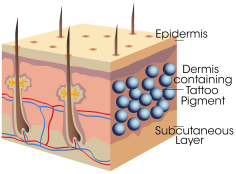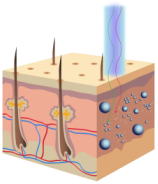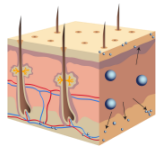Laser Tattoo Removal – How It Works

Redeem Clinic
Laser Tattoo removal * – How it works
A tattoo is a containment of ink trapped within the underlying dermis layer of the skin. The tattoo process uses a needle to place ink pigments into the dermis layer of the skin. During the healing process, after a tattoo procedure, the body sees the large ink particles as a threat to the system. As a natural way of defence the body encapsulates the ink with collagen fibres which then holds the tattooed ink particles firming in place within the dermis. Normally the human body’s natural healing process would remove any foreign objects in the dermis, the tattoo ink trapped within the collagen however is too large a particle to be removed and is therefore held permanently in place. Laser tattoo removal break up this ink.

Redeem’s Laser tattoo removal * service uses devices called a ND Yag Q-switch lasers, PicoSecond lasers as well as a Ruby laser. These devices create a very short pulse of laser energy that is emitted every 10 nanoseconds (1 nanosecond=1000,000,000 of a second), with the PicoSecond emitting every Picosecond (1 picosecond = 1000,000,000,000). These very short, intense pulses of light energy are absorbed quickly into the ink pigments causing them to shatter and break up. The selective targeting of ink pigment means that no damage is done to the surrounding skin tissue. The lasers wavelength is configured so that exactly the right amount of skin penetration is achieved to best target the ink pigment in the dermis.
Four different wavelengths of laser light can be emitted using the ND Yag lasers, Ruby lasers and Alexandrite lasers (Picosecond) enabling them to break up different coloured ink pigments. These wavelengths are extensively 1064nm, 543nm, 755nm and 694nm. These wave lengths are perfect for breaking up Blacks, Blues, Greens and Red Inks, they can also break up combination colours such as browns, pinks, purples, turquoises etc.


Immediately after treatment the top layer of the skin will appear white/opaque, this is the effect of the laser heating the fluid in the epidermis layer of the skin and will subside within 15 minutes of treatment. Because people cannot see the tattoo ink at this point and just the white/opaque area they often think the tattoo has been instantly removed, yet as explained above this actually happens over a course of several weeks after the treatment. Once the white/opaque area has subsided the skin will usually have some redness to the treated area. Entirely normal blistering, blood blisters, bruising and scabbing may also occur up to 8 hours or more after the treatment and should generally sound no cause for alarm. This is the body’s natural defence to the process being used to remove the ink pigments and shows that the immune system is working properly. An effective immune system is critical to ensure the fractured pigments can be expelled from the body to give the best possible results. This said, the bodies immune system tends to take on average a couple of weeks to start to remove the fragmented particles and prior to this taking place the tattoo can look darker on occasions. Over the several weeks after the treatment it is important that the patient stringently maintains the aftercare procedures to reduce the risk of scarring whilst also reducing the redness more quickly.
After a single laser tattoo removal * treatment the tattoo should start to fade. Redeem advise to wait at least 8 weeks after the area has been treated and wait until the area has fully healed before booking a further laser treatment. The longer you leave the area to heal the lower the risk of scaring on the next treatment and the more effective the immune system will be at removing the inks. Dependent on the tattoo location, size and pigment density etc it can take as little as 3 treatments to fully remove an amateur tattoo and up to 12 treatments or more to fully remove a large professional tattoo.
Tattoos containing colour mixes other that black, blue, browns, Greens and reds can prove somewhat more difficult to break up (although in most cases this simply results in additional treatments being required), so for more complex tattoos Redeem clinic also provides the Rejuvi non-laser tattoo removal procedure that is able to remove all colour ink pigments.
This specialist tattoo removal * treatment allows clients to have Rejuvi tattoo removal in Hull, Rejuvi tattoo removal in Sheffield, Rejuvi tattoo removal in Leeds, Rejuvi tattoo removal in Halifax and Rejuvi tattoo removal in our Leeds clinics. The laser tattoo removal service is only available in Hull.
With our ND yag laser, Ruby laser and Rejuvi tattoo removal * systems Redeem clinic are one of only a very few clinics in the clinics in the country with such a comprehensive approach to tattoo removal.
*Results may vary from person to person












